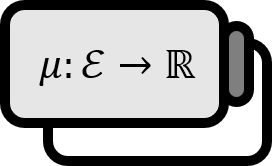Borel Sigma-Algebra, Borel Measurable Space
Theorem
Let $X$ be an arbitrary set. Given a non-empty set $A \subset \mathcal{P}(X)$, there exists the smallest $\sigma$-algebra, $\mathcal{E}_{A}$, that contains $A$.
Proof
We define $\mathcal{E}_{A}$ and show that it is an $\sigma$-algebra and then prove that it is the smallest1.
Let $S$ be the set of all $\sigma$-algebras that contain $A$.
$$ S:= \left\{ \mathcal{E} \subset \mathcal{P}(X)\ :\ \mathcal{E}\ \mathrm{is\ } \sigma \mathrm{-algebra, \ } A \subset \mathcal{E} \right\} $$
Then, it is obvious that $\mathcal{P}(X) \in S$. Therefore, $S \ne \varnothing$. Now, let $\mathcal{E}_{A} := \bigcap \limits_{\mathcal{E} \in S} \mathcal{E}$. Then, $A \subset \mathcal{E}_{A}$. Furthermore, it can be shown that $\mathcal{E}_{A}$ is an $\sigma$-algebra.
Given a set $X$, the collection []../1358) of subsets of $X$, $\mathcal{E} \subset \mathcal{P}(X)$, satisfying the below conditions is called an $\sigma$-algebra.
- (D1) $\varnothing, X \in \mathcal{E}$
- (D2) $E \in \mathcal{E} \implies E^c \in \mathcal{E}$
- (D3) $E_{k} \in \mathcal{E}\ (\forall k \in \mathbb{N}) \implies \bigcup_{k=1}^\infty E_{k} \in \mathcal{E}$
- (D4) $E_{k} \in \mathcal{E}\ (\forall\ k \in \mathbb{N}) \implies \bigcap_{k=1}^\infty E_{k} \in \mathcal{E}$
(D1)
Since each $\mathcal{E}$ is an $\sigma$-algebra, it is obvious that $\varnothing$, and $X$ is included. So by the definition of $\mathcal{E}_{A}$, $\varnothing$, and $X\in \mathcal{E}_{A}$ are obvious.
(D2)
Let $E \in \mathcal{E}_{A}$. Then, by the definition of $\mathcal{E}_{A}$, $E \in \mathcal{E}$ holds for each $\mathcal{E}$. Each $\mathcal{E}$ is an $\sigma$-algebra, so $E^c \in \mathcal{E}$ holds. Therefore, by the definition of $\mathcal{E}_{A}$, $E^c \in \mathcal{E}_{A}$ holds.
(D3)
As shown in condition (D2), using the definition of $\mathcal{E}_{A}$ and the fact that each $\mathcal{E}$ is an $\sigma$-algebra, this can be easily proven. (D4) automatically follows from (D3) according to De Morgan’s laws.
Therefore, $\mathcal{E}_{A}$ satisfies conditions (D1) ~ (D4), hence it is an $\sigma$-algebra. Now, let another $\sigma$-algebra that contains $A$ be $\mathcal{E}^{\prime}$. Then, by the definition of the set $S$, $\mathcal{E}^{\prime} \in S$ and obviously $\mathcal{E}_{A} \subset \mathcal{E}^{\prime}$ holds. Therefore, $\mathcal{E}_{A}$ is the smallest $\sigma$-algebra that includes $A$.
■
Definition
At this time, $\mathcal{E}_{A}$ is called the $\sigma$-algebra generated by A and is denoted as $\mathcal{G}(A)$.
Let the pair $(X,\mathcal{T})$ be called a topological space. By the definition of topology, $\mathcal{T} \subset \mathcal{P}(X)$ holds. Therefore, according to the above theorem, the smallest $\sigma$-algebra that includes $\mathcal{T}$ exists. This is denoted as $\mathcal{B}_\sigma (X) :=\mathcal{G}(\mathcal{T})$ and is called the Borel $\sigma$-algebra on the topological space $(X,\mathcal{T})$ or simply Borel algebra.
The element of $\mathcal{B}_\sigma (X)$ is called a Borel set and the pair $(X,\mathcal{B}_\sigma (X) )$ is called a Borel measurable space.
Simply put, the Borel algebra is the smallest $\sigma$-algebra that contains all open sets. Especially, all measures defined in Borel algebra are called Borel measures.
See Also
It means that the sigma field with unnecessary parts minimized. In this sense, the Borel sigma field is especially useful in discussing probability theory. ↩︎
